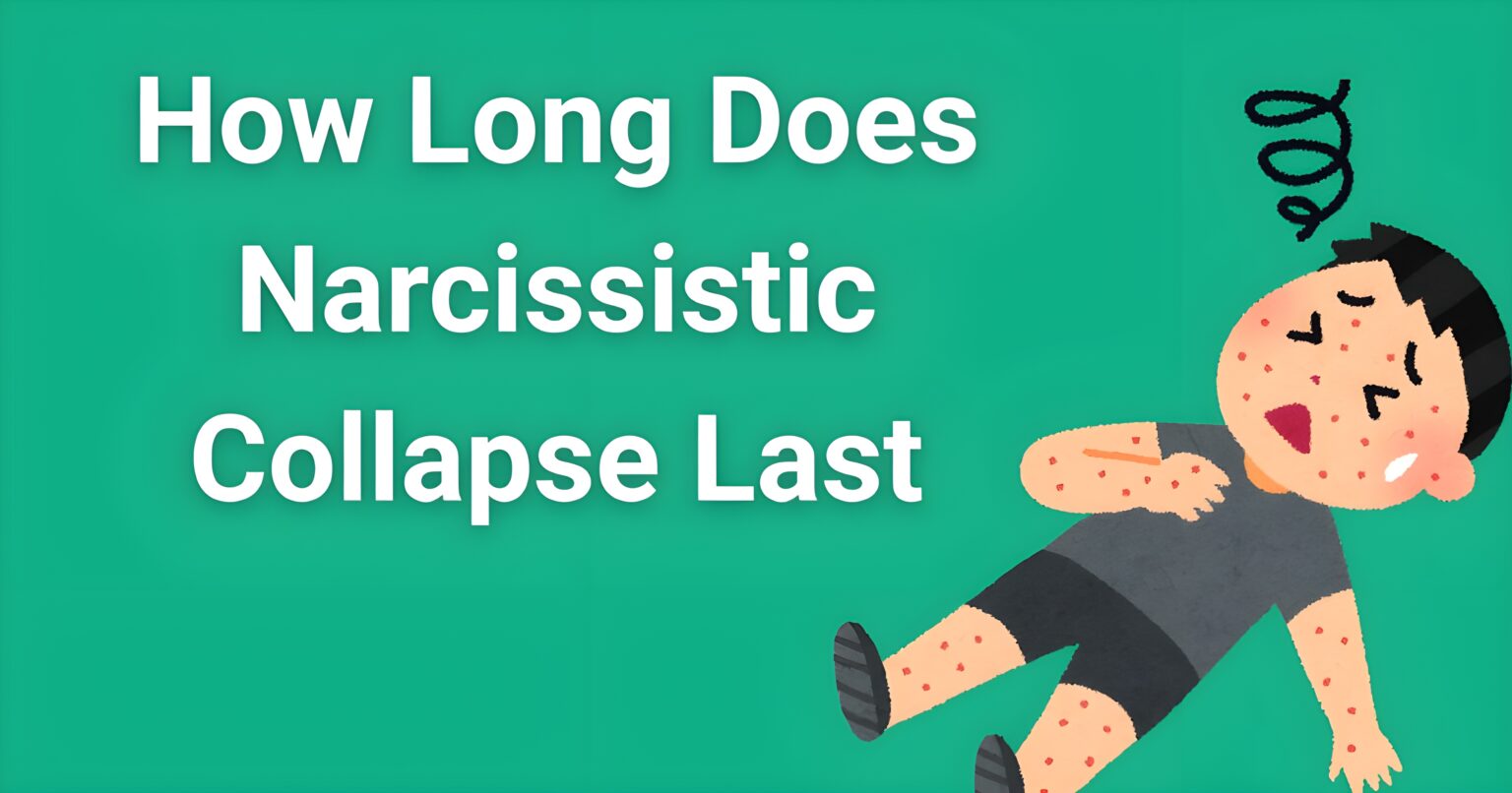How long does narcissistic collapse last? The 3 stages you’re about to discover will either prepare you for the most dangerous period of your relationship or help you understand why someone in your life has become unrecognizable. After working with thousands of survivors through NarcissismExposed.com as a Certified Narcissistic Abuse Specialist, I can tell you that understanding this timeline isn’t just academic—it’s essential for your safety and emotional survival.
- Understanding Narcissistic Collapse: The Foundation
- Stage 1: The Trigger and Initial Breakdown (2-6 weeks)
- Collapse Doesn’t Mean It’s Over
- Stage 2: The Deep Descent and Chaos (2-6 months)
- Stage 3: Attempted Reconstruction or Permanent Decline (3-12+ months)
- Collapse Won’t Give You Closure
- How Long Does Narcissistic Collapse Last: Factors That Influence Timeline
- Safety and Protection Strategies Throughout All Stages
- Key Takeaways: Navigating the Collapse Timeline
- Frequently Asked Questions
The brutal truth is that narcissistic collapse unfolds in three distinct stages over a period that can last anywhere from several weeks to over a year, with each stage presenting unique dangers and challenges for those around the collapsing narcissist. What you’re witnessing isn’t random chaos—it’s a predictable psychological breakdown that follows specific patterns and timelines.
Understanding how long narcissistic collapse lasts through its three stages gives you the roadmap you need to protect yourself, make informed decisions, and avoid the most dangerous mistakes that could put you at risk. The person you’re dealing with may seem like they’ve completely changed, but they’re actually following a well-documented psychological process that mental health professionals have been studying for decades.
This isn’t about the narcissist getting better or worse—it’s about understanding a complete psychological unraveling and rebuilding process that affects everyone in their orbit. Your safety, sanity, and future decisions depend on understanding exactly what you’re dealing with and how long it’s likely to continue.
Understanding Narcissistic Collapse: The Foundation
Before we explore how long narcissistic collapse lasts through its three stages, it’s crucial to understand what triggers this devastating psychological breakdown and why the timeline varies so dramatically between individuals. Narcissistic collapse occurs when the narcissist’s grandiose self-image becomes completely unsustainable, usually due to major life failures, exposure of their true nature, or loss of their primary sources of narcissistic supply.
Narcissistic collapse is fundamentally different from typical emotional breakdowns because it involves the complete failure of the psychological defense system that the narcissist has spent their entire life constructing. Think of it like a house of cards built on a foundation of lies, manipulation, and false superiority—when it falls, everything comes crashing down at once.
Common triggers that initiate the collapse include:
Major Life Failures: Job loss, business failure, bankruptcy, or other public failures that cannot be hidden or explained away through their usual manipulation tactics.
Relationship Losses: Divorce, abandonment by their primary source of supply, or multiple people cutting contact simultaneously, leaving them without their essential validation sources.
Exposure and Accountability: Being publicly exposed for their lies, manipulation, or abuse, particularly when the evidence is undeniable and they cannot gaslight their way out of consequences.
Aging and Health Issues: Physical decline that they cannot control or hide, forcing them to confront their mortality and limitations in ways their grandiose self-image cannot accommodate.
Legal or Financial Consequences: Facing real consequences for their actions that they cannot manipulate, charm, or lie their way out of.
According to research published in the Journal of Personality Disorders, narcissistic collapse represents a complete breakdown of the ego defenses that normally protect the narcissist from experiencing their underlying shame, emptiness, and self-loathing. When these defenses fail, they experience what psychologists describe as “psychological decompensation”—a complete inability to cope with reality using their normal mechanisms.
The reason understanding how long narcissistic collapse lasts through its three stages is so important is that each stage presents different risks and requires different protective strategies. During certain phases, the narcissist may be more dangerous, more manipulative, or more likely to attempt suicide or harm others. Other phases may present opportunities for family members to seek help or establish safety measures.
Stage 1: The Trigger and Initial Breakdown (2-6 weeks)
The first stage in understanding how long narcissistic collapse lasts begins with the triggering event and the initial psychological breakdown that follows. This stage typically lasts between two to six weeks, depending on the severity of the trigger and the narcissist’s available coping mechanisms and support systems.
During Stage 1, you’ll witness what appears to be a complete personality change as the narcissist’s usual confidence, charm, and control completely disappear. This isn’t temporary stress or a bad mood—it’s the beginning of a fundamental psychological crisis that will continue to unfold over the coming months.
The Initial Shock Phase (Days 1-7)
The first week after the triggering event represents the acute shock phase, where the narcissist’s brain literally cannot process what has happened to them. They may appear confused, disoriented, or in complete denial about the reality of their situation.
Common behaviors during the initial shock include:
Complete Denial: They may act as if the triggering event never happened or insist that it’s temporary and will be resolved quickly. This isn’t strategic lying—their brain genuinely cannot accept the reality of what’s occurred.
Manic Problem-Solving: Frantic attempts to fix the situation through their usual manipulation tactics, often making the situation worse through desperate, poorly thought-out actions.
Emotional Volatility: Rapid cycling between rage, panic, depression, and artificial confidence as their emotional regulation system completely fails.
Isolation or Clinging: They may completely withdraw from everyone or become desperately clingy with remaining sources of supply, unable to tolerate being alone with their thoughts.
Physical Symptoms: Sleep disturbances, appetite changes, and stress-related physical symptoms as their body responds to the psychological crisis.
The Reality Recognition Phase (Weeks 2-4)
As the shock wears off, the narcissist begins to recognize that their situation is real and serious, leading to what I call the “reality recognition phase.” This is often when they become most dangerous, as they realize their usual tactics aren’t working and may become desperate or vindictive.
During this phase, you may observe:
Blame and Rage: Intense anger directed at everyone they believe is responsible for their situation, often including people who had nothing to do with the triggering event.
Revenge Planning: Calculated attempts to punish those they blame for their collapse, which can include legal harassment, smear campaigns, or even threats of violence.
Desperate Manipulation: Increasingly extreme attempts to regain control, including threats of suicide, false emergencies, or elaborate lies designed to gain sympathy and support.
Identity Crisis: Confusion about who they are without their grandiose self-image, leading to erratic behavior and contradictory statements about their plans and feelings.
Collapse Doesn’t Mean It’s Over
That’s why you need a survival strategy. The Stuck Survival Workbook arms you with scripts, safety plans, and psychological defense tools you can use right now.

The Desperation Escalation (Weeks 4-6)
The final portion of Stage 1 involves escalating desperation as the narcissist realizes that their situation isn’t improving and their usual recovery methods aren’t working. This is often the most dangerous period for family members and former partners.
The desperation escalation typically includes:
Extreme Manipulation Attempts: Using their children, threatening suicide, or creating false emergencies to force others to help them or provide attention.
Financial Desperation: Attempting to access others’ resources through manipulation, theft, or legal pressure when their own resources are depleted.
Stalking or Harassment: Increasing contact attempts with former sources of supply, often escalating to stalking behavior when ignored.
Reality Distortion: Creating elaborate fantasy scenarios about how they’ll recover their former status, often involving unrealistic plans or magical thinking.
Substance Abuse: Increased use of alcohol, drugs, or other substances to cope with the psychological pain they’re experiencing.
Safety Considerations for Stage 1
Understanding how long narcissistic collapse lasts during Stage 1 is crucial for safety planning because this period represents the highest risk for violence, suicide attempts, and extreme manipulation. If you’re dealing with someone in Stage 1 collapse, prioritize your safety above all other considerations.
Safety strategies for Stage 1 include:
Maintain Distance: Avoid contact whenever possible, as they’re likely to be unpredictable and potentially dangerous during this phase.
Document Everything: Keep records of all contact attempts, threats, or concerning behaviors for potential legal protection.
Alert Support Networks: Inform trusted friends, family members, and potentially law enforcement about the situation so others can help monitor for escalating behavior.
Secure Your Resources: Protect your financial accounts, personal information, and physical safety from potential retaliation attempts.
Professional Support: Consider consulting with domestic violence professionals or therapists who understand narcissistic abuse for guidance specific to your situation.
Stage 2: The Deep Descent and Chaos (2-6 months)
The second stage in understanding how long narcissistic collapse lasts represents the longest and most unpredictable phase, typically lasting between two to six months. During this period, the narcissist experiences what psychologists call “psychological decompensation”—a complete breakdown of their normal coping mechanisms and identity structure.
Stage 2 is characterized by profound instability, depression, and increasingly erratic behavior as the narcissist struggles to rebuild their shattered self-image while dealing with the ongoing consequences of their collapse. This phase often involves multiple crisis cycles, failed recovery attempts, and gradually worsening mental health symptoms.
The Identity Dissolution Period (Months 1-2)
The early part of Stage 2 involves what I call “identity dissolution,” where the narcissist’s sense of self becomes increasingly fragmented and unstable. Without their grandiose self-image to anchor their identity, they often experience severe confusion about who they are and what they want.
During identity dissolution, you may observe:
Personality Fragmentation: They may seem like completely different people from day to day or even hour to hour, as they cycle through different personas trying to find one that works.
Memory Problems: Genuine confusion about past events, promises they’ve made, or actions they’ve taken, as their brain struggles to integrate their new reality with their former self-image.
Contradictory Behaviors: Actions that directly contradict their stated beliefs or previous patterns, reflecting their internal confusion and lack of stable identity.
Attachment Desperation: Frantic attempts to attach to new people or reattach to former relationships, often cycling through multiple targets rapidly.
Reality Testing Issues: Difficulty distinguishing between their internal fantasies and external reality, leading to decisions based on wishful thinking rather than actual circumstances.
The Cycling Crisis Pattern (Months 2-4)
The middle portion of Stage 2 typically involves repeating cycles of hope and despair as the narcissist attempts various strategies to rebuild their life and self-image. These cycles can be particularly exhausting for family members who may be pulled into repeated “rescue” scenarios.
The cycling pattern typically includes:
False Recovery Attempts: Periods where they appear to be getting better, making positive changes, and showing insight into their problems, followed by rapid returns to crisis behavior.
Relationship Cycling: Rapidly moving between different romantic partners, friendships, or professional relationships, often burning bridges quickly when people don’t meet their unrealistic expectations.
Project Obsessions: Becoming intensely focused on new business ventures, creative projects, or life changes that they believe will restore their former status, often abandoning these obsessions as quickly as they began.
Therapeutic Shopping: Cycling through different therapists, treatment programs, or self-help approaches without genuinely engaging in the therapeutic process.
Geographic Solutions: Believing that moving to a new location will solve their problems, often involving impulsive relocations that create additional instability.
The Deepening Depression Phase (Months 4-6)
As Stage 2 progresses, most narcissists experience increasingly severe depression as their repeated attempts to rebuild their grandiose self-image continue to fail. This depression is qualitatively different from healthy sadness because it’s mixed with rage, entitlement, and continued manipulation attempts.
The deepening depression typically involves:
Suicidal Ideation: Genuine thoughts of suicide mixed with manipulative suicide threats, making it difficult for others to know when to take threats seriously.
Chronic Rage: Persistent anger that may be directed at themselves, others, or life in general, often expressed through bitter complaints and blame.
Social Isolation: Withdrawing from most relationships due to shame, exhaustion, or burning bridges through inappropriate behavior.
Functional Decline: Inability to maintain basic responsibilities like work, personal hygiene, or household management as depression deepens.
Substance Abuse Escalation: Increasing reliance on alcohol, drugs, or other substances to cope with psychological pain.
Understanding the Chaos Patterns
What makes Stage 2 particularly challenging for family members is that how long narcissistic collapse lasts during this phase depends heavily on external factors that may be partially within others’ control. The narcissist’s recovery timeline can be significantly extended by well-meaning family members who provide rescue, resources, or emotional support that enables their dysfunction.
Factors that can extend Stage 2 include:
Enabling Behaviors: Family members who provide financial support, housing, or emotional rescue that removes natural consequences and prevents the narcissist from hitting “rock bottom.”
New Supply Sources: Finding new romantic partners or friendships that temporarily boost their self-esteem and delay the necessary psychological work.
External Validation: Job opportunities, legal victories, or other external successes that allow them to avoid dealing with their underlying psychological issues.
Substance Abuse: Drug or alcohol use that numbs their emotional pain but prevents genuine psychological processing and healing.
Therapeutic Resistance: Engaging with therapy or treatment in superficial ways that provide the appearance of progress without genuine change.
Stage 3: Attempted Reconstruction or Permanent Decline (3-12+ months)
The final stage in understanding how long narcissistic collapse lasts represents the narcissist’s attempts to rebuild their life and identity, though the outcome of this stage varies dramatically between individuals. Stage 3 can last anywhere from three months to over a year, and in some cases, the narcissist never fully recovers their previous level of functioning.
Stage 3 typically results in one of three outcomes: reconstruction of a modified grandiose self, permanent psychological decline, or rare instances of genuine personality change through intensive therapeutic intervention. Understanding which direction the collapse is heading becomes crucial for family members making long-term decisions about their relationships and safety.
Path 1: The Grandiose Reconstruction (3-8 months)
The most common outcome of narcissistic collapse is what I call “grandiose reconstruction,” where the narcissist gradually rebuilds a modified version of their previous false self. This isn’t genuine healing—it’s the construction of new defense mechanisms and manipulation strategies based on their collapse experience.
During grandiose reconstruction, you’ll observe:
Strategic Vulnerability: Calculated sharing of their collapse experience to gain sympathy and position themselves as survivors who’ve overcome great adversity.
Modified Manipulation Tactics: New approaches to controlling others that incorporate lessons learned during their collapse, often making them more sophisticated manipulators.
Victim Identity Integration: Adopting a permanent victim identity related to their collapse, using this to justify future manipulation and avoid accountability.
Spiritual or Therapeutic Bypassing: Using religion, therapy, or self-help movements as new sources of superiority and ways to manipulate others through appearing “enlightened.”
Relationship Pattern Repetition: Returning to the same basic relationship patterns but with new awareness of how to avoid the specific triggers that caused their previous collapse.
The key warning sign of grandiose reconstruction is that while their behavior may appear improved, it lacks genuine empathy, accountability, or consideration for others’ wellbeing. They’ve essentially learned to be better manipulators rather than better people.
Path 2: Permanent Psychological Decline (ongoing)
In some cases, narcissistic collapse results in permanent psychological decline where the individual never recovers their previous level of functioning. This outcome is more likely when the collapse was triggered by multiple severe stressors, involved significant substance abuse, or occurred later in life when psychological flexibility is reduced.
Permanent decline typically involves:
Chronic Depression and Anxiety: Persistent mental health symptoms that don’t respond well to treatment due to underlying personality structure issues.
Functional Impairment: Ongoing inability to maintain employment, relationships, or basic life responsibilities at their previous level.
Increased Isolation: Progressive withdrawal from social relationships due to shame, paranoia, or inability to maintain their manipulative facade.
Health Deterioration: Physical health problems that result from chronic stress, poor self-care, or substance abuse during the collapse period.
Cognitive Decline: In older narcissists, the stress of collapse can accelerate cognitive decline or reveal previously hidden cognitive issues.
While permanent decline might seem like justice to those who’ve been abused, it’s important to understand that this outcome often creates new challenges for family members who may feel pressure to provide care or support.
Path 3: Genuine Personality Change (rare, 12+ months)
The rarest outcome of narcissistic collapse is genuine personality change, which requires intensive therapeutic intervention, complete honesty about their previous behavior, and sustained commitment to psychological growth. This path is so uncommon that it should never be counted on or used as a reason to maintain contact with a collapsed narcissist.
Genuine change indicators include:
Sustained Accountability: Consistent acknowledgment of specific harm they’ve caused others without minimizing, excusing, or requesting forgiveness.
Behavioral Consistency: Actions that consistently match their stated commitment to change over extended periods without external pressure or rewards.
Empathy Development: Demonstrated ability to understand and care about others’ experiences without making it about themselves.
Boundary Respect: Accepting others’ boundaries and decisions without manipulation, guilt trips, or retaliation attempts.
Internal Motivation: Evidence that their change efforts are internally motivated rather than driven by external consequences or image management.
It’s crucial to understand that even when genuine change occurs, it doesn’t erase the harm that was done, nor does it obligate former victims to maintain relationships or provide forgiveness.
Collapse Won’t Give You Closure
The Clarity Report cuts through the noise and shows you exactly what’s happening in YOUR story, so you stop living in doubt.
How Long Does Narcissistic Collapse Last: Factors That Influence Timeline
Understanding how long narcissistic collapse lasts through its three stages requires examining the specific factors that can extend or shorten each phase. These variables help explain why some collapses resolve in a few months while others stretch on for years or never fully resolve.
Individual Factors
Age and Life Stage: Younger narcissists often recover more quickly because they have more opportunities to rebuild their lives and identities. Older narcissists may experience longer collapses or permanent decline due to reduced psychological flexibility and fewer opportunities for reinvention.
Severity of Narcissistic Traits: Those with more severe narcissistic personality disorder typically experience longer, more chaotic collapses because their entire identity structure is more dependent on grandiose self-image.
Comorbid Mental Health Issues: Depression, anxiety, substance abuse, or other mental health conditions can significantly extend the collapse timeline and complicate recovery.
Previous Trauma History: Narcissists with significant childhood trauma may experience more severe collapses as the breakdown triggers underlying traumatic memories and responses.
Physical Health Status: Medical problems, chronic illness, or physical disabilities can extend collapse duration and affect the possible outcomes.
Environmental Factors
Support System Responses: Family members who provide enabling support often extend the collapse by preventing natural consequences, while those who maintain boundaries may accelerate movement through the stages.
Financial Resources: Access to money can extend collapses by funding destructive behaviors, while financial pressure can motivate quicker resolution.
Legal Consequences: Ongoing legal issues can prolong the collapse period and affect which outcome path the narcissist eventually follows.
Treatment Engagement: Genuine therapeutic engagement can shorten the timeline, while superficial therapy participation often extends it.
New Relationship Opportunities: Access to new sources of narcissistic supply can interrupt the collapse process and lead to grandiose reconstruction rather than genuine healing.
Systemic Factors
Cultural and Social Context: Communities that prioritize appearance and success may make recovery more difficult by reinforcing narcissistic values.
Professional Opportunities: Career setbacks can extend collapses, while professional success can enable grandiose reconstruction.
Family Dynamics: Family systems that have historically enabled narcissistic behavior may unconsciously work to restore previous dynamics.
Treatment Quality: Access to skilled therapists who understand personality disorders affects both timeline and outcomes.
Safety and Protection Strategies Throughout All Stages
Understanding how long narcissistic collapse lasts through its three stages is most valuable when it informs safety and protection strategies for those affected by the collapsing narcissist. Each stage requires different approaches to maintain physical and emotional safety.
Universal Safety Principles
Regardless of which stage you’re dealing with, certain safety principles apply throughout the entire collapse timeline:
Document Everything: Keep detailed records of all interactions, threats, concerning behaviors, and attempts at manipulation. This documentation may be crucial for legal protection or restraining orders.
Maintain Professional Support: Work with therapists, domestic violence counselors, or other professionals who understand narcissistic abuse and can provide ongoing guidance.
Financial Protection: Secure your financial accounts, credit reports, and personal information from potential retaliation or exploitation attempts.
Communication Boundaries: Limit communication to essential matters only, preferably in writing, and avoid emotional responses to their manipulation attempts.
Support Network Activation: Keep trusted friends and family informed about the situation so they can provide reality checks and practical support.
Stage-Specific Safety Strategies
Stage 1 Safety Focus: During the initial breakdown, prioritize immediate physical safety and crisis management. This is when narcissists are most likely to become violent, make serious suicide threats, or engage in stalking behavior.
Stage 2 Safety Focus: During the chaos phase, focus on protecting yourself from manipulation attempts and avoiding being pulled into their crisis cycles. This stage often involves repeated “emergencies” designed to force contact and support.
Stage 3 Safety Focus: During reconstruction attempts, be particularly wary of seemingly positive changes that may be part of a more sophisticated manipulation strategy. Don’t be fooled by apparent improvement without sustained behavioral evidence.
Long-Term Relationship Decisions
Understanding how long narcissistic collapse lasts helps inform difficult decisions about maintaining or ending relationships with the collapsed narcissist. These decisions are deeply personal and depend on individual circumstances, but certain principles can guide the process.
Consider permanent distance if:
- You were previously abused by this person
- They show no genuine accountability for past harm
- Their collapse involves threats or violence toward you
- You have children who need protection from their instability
- Your own mental health is suffering from continued contact
Structured contact might be possible if:
- Legal requirements (custody) mandate some level of contact
- They demonstrate genuine accountability and therapeutic engagement
- Professional support confirms they’re following Path 3 (genuine change)
- You have strong boundaries and professional support for yourself
- Their behavior consistently matches their stated commitment to change
Key Takeaways: Navigating the Collapse Timeline
Understanding how long narcissistic collapse lasts through its three stages—initial breakdown (2-6 weeks), deep descent and chaos (2-6 months), and attempted reconstruction or decline (3-12+ months)—provides the roadmap needed to protect yourself and make informed decisions during this challenging period.
Remember these crucial insights:
- Narcissistic collapse follows predictable patterns despite appearing chaotic – each stage has characteristic behaviors and timeframes
- Stage 1 represents the highest danger period requiring immediate safety measures and professional guidance
- Stage 2’s cycling crises can last months and often involve manipulation attempts to pull others into rescue scenarios
- Stage 3 outcomes vary dramatically with grandiose reconstruction being most common, permanent decline possible, and genuine change extremely rare
- Timeline factors include age, severity, support responses, and treatment engagement – enabling behaviors often extend the collapse period
- Your safety is more important than their recovery – maintain boundaries and protection regardless of which stage they’re experiencing
The path forward involves:
- Prioritizing your physical and emotional safety throughout all stages
- Understanding that apparent improvement may be reconstruction rather than genuine change
- Documenting concerning behaviors and maintaining professional support
- Making relationship decisions based on sustained behavioral evidence rather than promises
- Recognizing that your confusion and concern are normal responses to abnormal behavior
Understanding how long narcissistic collapse lasts isn’t about fixing or helping the collapsed narcissist—it’s about protecting yourself and making informed decisions during a period that can be extremely dangerous and confusing. When someone asks about the timeline and stages of narcissistic collapse, they’re usually trying to understand whether they’re safe, whether the chaos will end, and whether the person they’re dealing with will ever return to normal functioning.
The honest answer is that while the acute crisis will eventually end, the person who emerges from collapse may be significantly different from who they were before—and often not in ways that make them safer or healthier to be around. Your wellbeing, safety, and future happiness are more important than understanding or supporting someone through their psychological collapse.
Frequently Asked Questions
Is narcissistic collapse permanent or will they eventually go back to their old behavior?
Narcissistic collapse is rarely permanent in the sense of lasting forever, but the person who emerges is often fundamentally changed from who they were before. Most commonly, they rebuild a modified version of their grandiose self that incorporates lessons learned during collapse, often making them more sophisticated manipulators rather than genuinely healthier people. Complete return to their previous functioning is possible but usually indicates they’ve reconstructed their false self rather than achieved genuine healing. Only in very rare cases with intensive therapeutic intervention might you see authentic personality change, and even then, it doesn’t erase past harm or obligate continued relationships.
Should I help them during their collapse or maintain distance for my safety?
Maintaining distance is almost always the safest choice during narcissistic collapse, especially if you’ve previously been abused by this person. Their collapse doesn’t change their fundamental inability to have healthy relationships, and they may actually become more dangerous during this vulnerable period. Any help you provide often enables their dysfunction and extends the collapse timeline rather than genuinely helping them recover. If legal obligations like custody require some contact, work with professionals to establish the minimum necessary interaction while protecting yourself. Remember that you cannot save someone from narcissistic collapse—they must do the psychological work themselves.
How can I tell if their apparent recovery is genuine or just another manipulation?
Genuine recovery from narcissistic collapse is extremely rare and requires sustained behavioral change over years, not months. True change involves consistent accountability for past harm without excuses, respect for others’ boundaries without retaliation, demonstrated empathy that doesn’t center on themselves, and internal motivation for change rather than external pressure. Be especially wary of quick apparent improvements, spiritual or therapeutic language used to avoid accountability, or dramatic declarations of change that aren’t backed by consistent actions. Most “recovery” during collapse is actually reconstruction of a modified false self designed to regain control and access to narcissistic supply.
What should I do if they threaten suicide during their collapse?
Suicide threats during narcissistic collapse should always be taken seriously, but that doesn’t mean you should abandon your boundaries or safety measures. Contact emergency services (911) or crisis intervention professionals rather than trying to handle the situation yourself. Many narcissists use suicide threats as manipulation tactics, but some may genuinely be at risk due to their psychological instability. Professional crisis responders can assess the situation appropriately and provide necessary intervention without compromising your safety. Document these threats and continue maintaining your boundaries while ensuring professional help is available.
How long should I wait to see if they’ve genuinely changed before making relationship decisions?
If you’re considering any relationship with someone who’s experienced narcissistic collapse, mental health professionals recommend observing consistent behavioral change for a minimum of 2-3 years before considering it potentially genuine. However, this timeline should only apply if they’ve demonstrated full accountability for past harm, engaged in intensive therapy with specialists in personality disorders, and shown sustained respect for your boundaries without any manipulation attempts. Most importantly, even genuine change doesn’t obligate you to maintain a relationship or provide forgiveness. Your decision should be based on your own wellbeing and safety rather than their recovery progress.
Can narcissistic collapse happen more than once to the same person?
Yes, narcissists can experience multiple collapses throughout their lifetime, especially if they rebuild their grandiose self without addressing underlying psychological issues. Each collapse is typically triggered by major life failures, exposure, or loss of narcissistic supply. Subsequent collapses may be more severe because their coping mechanisms become less effective over time, and they may have fewer resources and relationships to fall back on. This pattern of repeated collapse and reconstruction is why understanding the timeline and stages is so important for protecting yourself long-term, rather than viewing collapse as a one-time event that will resolve their personality issues permanently.
What’s the difference between narcissistic collapse and a normal mental health crisis?
Narcissistic collapse differs from typical mental health crises in several key ways: it involves the complete breakdown of their false self and defense mechanisms rather than temporary stress responses, often includes increased manipulation and blame toward others rather than taking responsibility, typically involves rage and entitlement mixed with depression rather than healthy sadness, and shows little genuine empathy for how their crisis affects others. Normal mental health crises usually involve people seeking appropriate help, taking responsibility for their role in problems, and showing concern for their impact on others. The collapse timeline is also much longer and more chaotic than typical crisis resolution, and recovery often involves rebuilding manipulation strategies rather than genuine healing.






